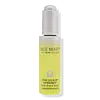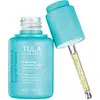What's inside
What's inside
 Key Ingredients
Key Ingredients

 Benefits
Benefits

 Concerns
Concerns

 Ingredients Side-by-side
Ingredients Side-by-side

Aloe Barbadensis Leaf Juice
Skin ConditioningVitis Vinifera Juice
AntioxidantPyrus Malus Juice
Skin ConditioningPentylene Glycol
Skin ConditioningGlycerin
HumectantWater
Skin ConditioningStearyl Alcohol
EmollientSimmondsia Chinensis Seed Oil
EmollientMalus Domestica Fruit Cell Culture Extract
Skin ConditioningVitis Vinifera Vine Extract
Skin ConditioningOpuntia Ficus-Indica Stem Extract
Skin ConditioningHyaluronic Acid
HumectantPanthenol
Skin ConditioningAscorbyl Glucoside
AntioxidantTocopherol
AntioxidantButyrospermum Parkii Butter
Skin ConditioningHydrolyzed Jojoba Esters
Skin ConditioningAlgin
MaskingBorago Officinalis Seed Oil
EmollientRosa Canina Fruit Oil
EmollientLinum Usitatissimum Seed Oil
PerfumingArginine
MaskingCetearyl Olivate
Sorbitan Olivate
EmulsifyingPolyglyceryl-6 Distearate
EmulsifyingXanthan Gum
EmulsifyingCitric Acid
BufferingPotassium Sorbate
PreservativeSodium Benzoate
MaskingLitsea Cubeba Fruit Oil
MaskingCinnamomum Camphora Bark Oil
MaskingLimonene
PerfumingLinalool
PerfumingCitral
PerfumingAloe Barbadensis Leaf Juice, Vitis Vinifera Juice, Pyrus Malus Juice, Pentylene Glycol, Glycerin, Water, Stearyl Alcohol, Simmondsia Chinensis Seed Oil, Malus Domestica Fruit Cell Culture Extract, Vitis Vinifera Vine Extract, Opuntia Ficus-Indica Stem Extract, Hyaluronic Acid, Panthenol, Ascorbyl Glucoside, Tocopherol, Butyrospermum Parkii Butter, Hydrolyzed Jojoba Esters, Algin, Borago Officinalis Seed Oil, Rosa Canina Fruit Oil, Linum Usitatissimum Seed Oil, Arginine, Cetearyl Olivate, Sorbitan Olivate, Polyglyceryl-6 Distearate, Xanthan Gum, Citric Acid, Potassium Sorbate, Sodium Benzoate, Litsea Cubeba Fruit Oil, Cinnamomum Camphora Bark Oil, Limonene, Linalool, Citral
Water
Skin Conditioning3-O-Ethyl Ascorbic Acid
Skin ConditioningLactococcus Ferment Lysate
Skin ConditioningPropanediol
Solvent1,2-Hexanediol
Skin ConditioningAscorbyl Glucoside
AntioxidantSodium Citrate
BufferingPentylene Glycol
Skin ConditioningCichorium Intybus Root Extract
MaskingMelia Azadirachta Leaf Extract
Skin ConditioningMelia Azadirachta Flower Extract
Skin ConditioningCorallina Officinalis Extract
Skin ConditioningCurcuma Longa Root Extract
MaskingOcimum Basilicum Flower/Leaf Extract
TonicLactic Acid
BufferingOcimum Sanctum Leaf Extract
Skin ConditioningVaccinium Vitis-Idaea Fruit Extract
AntioxidantCitrus Unshiu Peel Extract
MaskingHippophae Rhamnoides Fruit Extract
Skin ConditioningLitchi Chinensis Seed Extract
Skin ConditioningMangifera Indica Leaf Extract
Skin ConditioningGold
Cosmetic ColorantGlutathione
Hydroxyacetophenone
AntioxidantAcetyl Cysteine
AntioxidantSodium Sulfite
PreservativeSorbitol
HumectantCitric Acid
BufferingSclerotium Gum
Emulsion StabilisingXanthan Gum
EmulsifyingCaprylyl Glycol
EmollientAscorbic Acid
AntioxidantSodium Phytate
Lecithin
EmollientPullulan
Silica
AbrasiveSodium Chloride
MaskingSodium Benzoate
MaskingWater, 3-O-Ethyl Ascorbic Acid, Lactococcus Ferment Lysate, Propanediol, 1,2-Hexanediol, Ascorbyl Glucoside, Sodium Citrate, Pentylene Glycol, Cichorium Intybus Root Extract, Melia Azadirachta Leaf Extract, Melia Azadirachta Flower Extract, Corallina Officinalis Extract, Curcuma Longa Root Extract, Ocimum Basilicum Flower/Leaf Extract, Lactic Acid, Ocimum Sanctum Leaf Extract, Vaccinium Vitis-Idaea Fruit Extract, Citrus Unshiu Peel Extract, Hippophae Rhamnoides Fruit Extract, Litchi Chinensis Seed Extract, Mangifera Indica Leaf Extract, Gold, Glutathione, Hydroxyacetophenone, Acetyl Cysteine, Sodium Sulfite, Sorbitol, Citric Acid, Sclerotium Gum, Xanthan Gum, Caprylyl Glycol, Ascorbic Acid, Sodium Phytate, Lecithin, Pullulan, Silica, Sodium Chloride, Sodium Benzoate
Ingredients Explained
These ingredients are found in both products.
Ingredients higher up in an ingredient list are typically present in a larger amount.
Ascorbyl Glucoside is a stable form of Vitamin C. It is created by combining glucose from starch.
When applied to skin, Ascorbyl Glucoside turns into Ascorbic Acid.
Ascorbyl Glucoside is an antioxidant. Antioxidants help fight free-radicals, or molecules that may damage skin cells.
It can help to reduce redness, improve skin texture, reduce the effects of aging, reduce the visibility of dark spots, and brighten skin.
Read more about other types of Vitamin C:
Learn more about Ascorbyl GlucosideCitric Acid is an alpha hydroxy acid (AHA) naturally found in citrus fruits like oranges, lemons, and limes.
Like other AHAs, citric acid can exfoliate skin by breaking down the bonds that hold dead skin cells together. This helps reveal smoother and brighter skin underneath.
However, this exfoliating effect only happens at high concentrations (20%) which can be hard to find in cosmetic products.
Due to this, citric acid is usually included in small amounts as a pH adjuster. This helps keep products slightly more acidic and compatible with skin's natural pH.
In skincare formulas, citric acid can:
While it can provide some skin benefits, research shows lactic acid and glycolic acid are generally more effective and less irritating exfoliants.
Most citric acid used in skincare today is made by fermenting sugars (usually from molasses). This synthetic version is identical to the natural citrus form but easier to stabilize and use in formulations.
Read more about some other popular AHA's here:
Learn more about Citric AcidPentylene glycol is typically used within a product to thicken it. It also adds a smooth, soft, and moisturizing feel to the product. It is naturally found in plants such as sugar beets.
The hydrophilic trait of Pentylene Glycol makes it a humectant. As a humectant, Pentylene Glycol helps draw moisture from the air to your skin. This can help keep your skin hydrated.
This property also makes Pentylene Glycol a great texture enhancer. It can also help thicken or stabilize a product.
Pentylene Glycol also acts as a mild preservative and helps to keep a product microbe-free.
Some people may experience mild eye and skin irritation from Pentylene Glycol. We always recommend speaking with a professional about using this ingredient in your routine.
Pentylene Glycol has a low molecular weight and is part of the 1,2-glycol family.
Learn more about Pentylene GlycolSodium Benzoate is a preservative. It's used in both cosmetic and food products to inhibit the growth of mold and bacteria. It is typically produced synthetically.
Both the US FDA and EU Health Committee have approved the use of sodium benzoate. In the US, levels of 0.1% (of the total product) are allowed.
Sodium benzoate works as a preservative by inhibiting the growth of bacteria inside of cells. It prevents the cell from fermenting a type of sugar using an enzyme called phosphofructokinase.
It is the salt of benzoic acid. Foods containing sodium benzoate include soda, salad dressings, condiments, fruit juices, wines, and snack foods.
Studies for using ascorbic acid and sodium benzoate in cosmetics are lacking, especially in skincare routines with multiple steps.
We always recommend speaking with a professional, such as a dermatologist, if you have any concerns.
Learn more about Sodium BenzoateWater. It's the most common cosmetic ingredient of all. You'll usually see it at the top of ingredient lists, meaning that it makes up the largest part of the product.
So why is it so popular? Water most often acts as a solvent - this means that it helps dissolve other ingredients into the formulation.
You'll also recognize water as that liquid we all need to stay alive. If you see this, drink a glass of water. Stay hydrated!
Learn more about WaterXanthan gum is used as a stabilizer and thickener within cosmetic products. It helps give products a sticky, thick feeling - preventing them from being too runny.
On the technical side of things, xanthan gum is a polysaccharide - a combination consisting of multiple sugar molecules bonded together.
Xanthan gum is a pretty common and great ingredient. It is a natural, non-toxic, non-irritating ingredient that is also commonly used in food products.
Learn more about Xanthan Gum